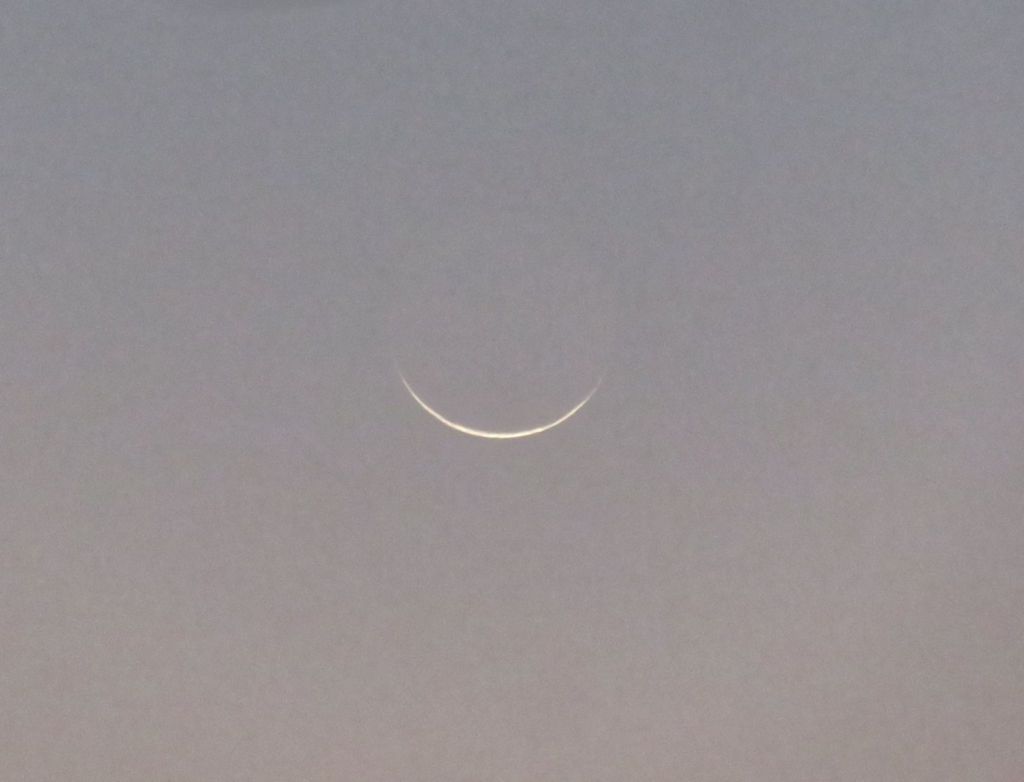Sky Report: April 17 – 23

The crescent moon only 2% illuminated, captured by Mohamed Mohamed in Libya in 2022.
People who like a challenge should try to spot the ultra-thin crescent moon, only 1% illuminated by the sun, immediately after sunset on the 20th when the moon is a scant 23 hours past new. Find a spot with a very low western horizon and use binoculars. It will be 5° below Mercury at the 7 o’clock position, but at 2nd magnitude Mercury itself won’t be easy to see. The following night the moon will be higher and 4% illuminated – still the thinnest of crescents and an unusual sight in binoculars. Early spring is the best time of year to see the youngest of moons for exactly the same reason it’s the best time of year to see Mercury, as explained last week, so this evening is an excellent occasion to try for your record young new moon.
Three planets are visible tonight, two easily and one with difficulty. The hard one is Mercury, just mentioned, which on the 17th sets 90 minutes after the sun; after the 17th it sets even earlier. Don’t bother unless you’re up for the challenge and then you’ll need binoculars.
In contrast, Venus is the brightest thing in the night sky. It’s 1/3 of the way up the western sky in evening twilight, and it sets 3½ hours after the sun. Venus is moving eastward through Taurus, passing 5° to the right of the Hyades Star Cluster from the 15th through 20th; watch it move nightly against the background of distant stars.
Mars is as bright as the brighter stars and it’s noticeably orange in color, and you’ll find it in the middle of Gemini, the Twins, and twice as high as Venus as darkness falls. Mars is midway between Procyon to the left and Capella to the right, and it’s at the bottom of a narrow V with Castor (L) and Pollux (R) above. Almost straight below Mars is Orion, the Hunter – a familiar winter constellation that lingers into the spring.
The first decent meteor shower in months peaks early on the morning of the 23rd when Lyrid meteors flash overhead. An observer in a dark location might see one meteor every 4 minutes radiate from near the bright star Vega. Better showers are ahead.
An unusual solar eclipse happens on the opposite side of the earth on the 20th, and of course we won’t see it. Mark your calendars for an unusual annular, or ring, solar eclipse that passes through Utah on October 14, 2023.
All stargazers appreciate, and rely on, a dark sky, yet dark skies are becoming a rarity. The International Dark-Sky Association was founded in 1988 to help preserve dark skies for many important practical reasons beyond the esthetics of being able to enjoy a star-filled sky. Some communities have been surprisingly successful in limiting wasted and harmful light (I’ve just returned from Tucson where they’ve had outstanding success); other communities not so much. April 15-22 is “International Dark Sky Week”; Google it for more information.
The Sky Report is presented as a public service by the Stellar Vista Observatory, a nonprofit organization based in Kanab, Utah, which provides opportunities for people to observe, appreciate, and comprehend our starry night sky. Additional information is at www.stellarvistaobservatory.org. Send questions and comments to John@StargazingAdventures.org.






Comments are closed.